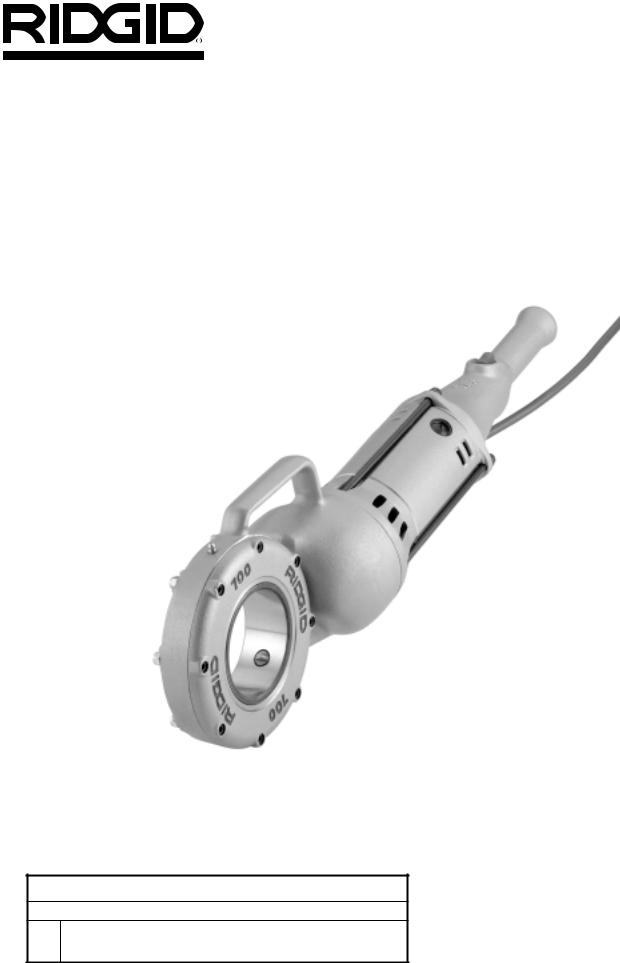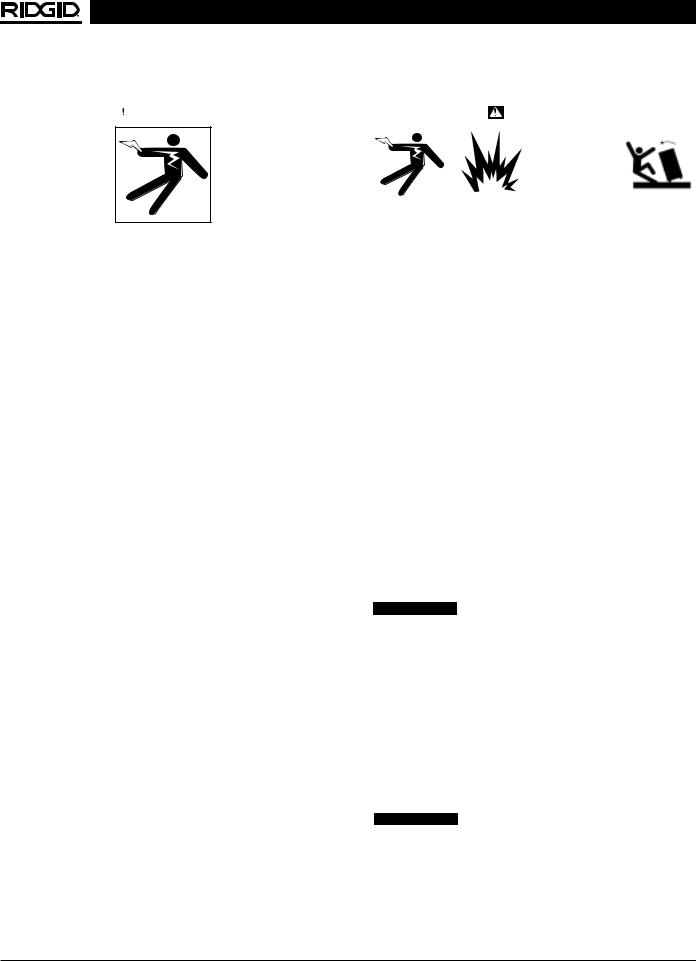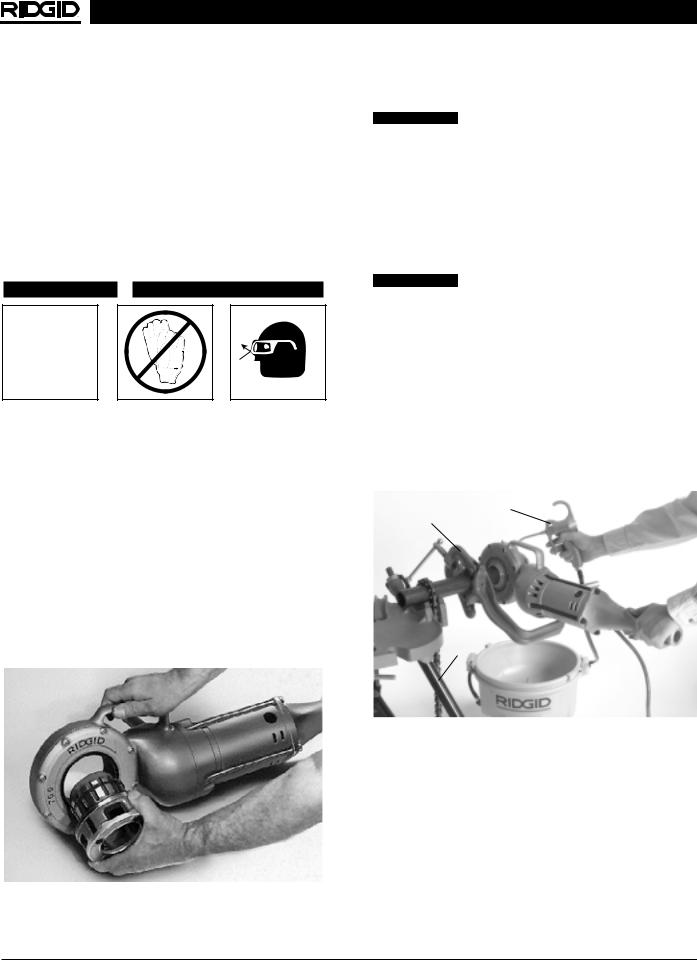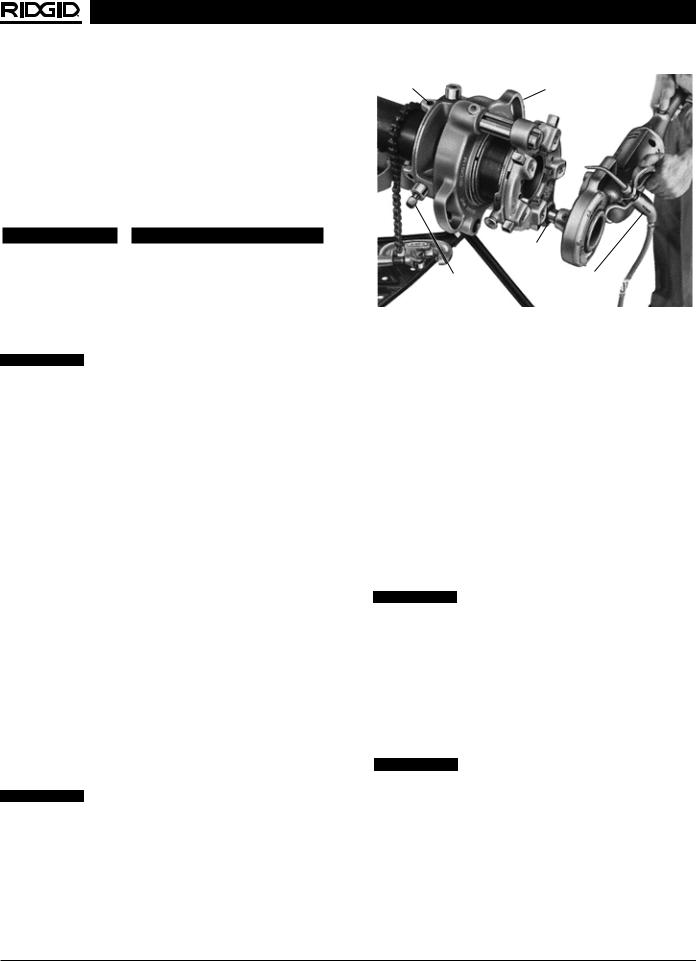RIDGID 700 User Manual

700 Portable Power
Drive
OPERATOR’S
MANUAL
•Français – 13
•Castellano – pág. 27
 WARNING!
WARNING!
Read this Operator’s Manual carefully before using this tool. Failure to understand and follow the contents of this manual may result in electrical shock, fire and/or serious personal injury

No. 700 Portable Power Drive |
|
Table of Contents |
|
Recording Form for Machine Model and Serial Number ........................................................................................... |
1 |
General Safety Information |
|
Work Area Safety........................................................................................................................................................ |
2 |
Electrical Safety .......................................................................................................................................................... |
2 |
Personal Safety........................................................................................................................................................... |
2 |
Tool Use and Care...................................................................................................................................................... |
3 |
Service ........................................................................................................................................................................ |
3 |
Specific Safety Information |
|
Power Drive Safety ..................................................................................................................................................... |
3 |
Description, Specifications and Standard Equipment |
|
Description .................................................................................................................................................................. |
3 |
Specifications.............................................................................................................................................................. |
4 |
Standard Equipment ................................................................................................................................................... |
4 |
Accessories................................................................................................................................................................. |
4 |
Power Drive Inspection................................................................................................................................................. |
5 |
Tool and Work Area Set-Up.......................................................................................................................................... |
5 |
Operating Instructions For Threading With Drop Head Die Heads .......................................................................... |
6 |
Operation Instructions For Threading With Geared Threaders ................................................................................ |
7 |
Adjusting Nos. 141 and 161 Geared Threaders ......................................................................................................... |
8 |
Cam Plate (Pipe Size) Adjustment Procedure ............................................................................................................ |
8 |
Thread Size Adjustment Procedure ............................................................................................................................ |
8 |
Changing Posts For Straight Or Tapered Threads ..................................................................................................... |
8 |
Changing Die Set........................................................................................................................................................ |
9 |
Threading With Geared Threaders ............................................................................................................................. |
9 |
Accessories ................................................................................................................................................................. |
10 |
Maintenance Instructions |
|
Motor Brush Replacement ........................................................................................................................................ |
10 |
Lubrication ................................................................................................................................................................ |
10 |
Tool Storage ................................................................................................................................................................ |
10 |
Service and Repair ...................................................................................................................................................... |
10 |
Troubleshooting .......................................................................................................................................................... |
11 |
Wiring Diagram............................................................................................................................................................ |
12 |
Lifetime Warranty ......................................................................................................................................... |
Back Cover |
ii |
Ridge Tool Company |

700
Portable Power Drive
700 Portable Power Drive
Record Serial Number below and retain product serial number which is located on nameplate.
Serial
No.

No. 700 Portable Power Drive
General Safety Information
WARNING! Read and understand all instructions. Failure to follow all instructions listed below may result in electric shock, fire, and/or serious personal injury.
SAVE THESE INSTRUCTIONS!
Work Area Safety
•Keep your work area clean and well lit. Cluttered benches and dark areas invite accidents.
•Do not operate tools in explosive atmospheres, such as in the presence of flammable liquids, gases, or dust. Tools create sparks which may ignite the dust or fumes.
•Keep by-standers, children, and visitors away while operating a tool. Distractions can cause you to lose control.
•Keep floors dry and free of slippery materials such as oil. Slippery floors invite accidents.
Electrical Safety
•Grounded tools must be plugged into an outlet, properly installed and grounded in accordance with all codes and ordinances. Never remove the grounding prong or modify the plug in any way. Do not use any adapter plugs. Check with a qualified electrician if you are in doubt as to whether the outlet is properly grounded. If the tool should electrically malfunction or break down, grounding provides a low resistance path to carry electricity away from the user.
Cover of grounded outlet box
Grounding Prong |
Grounding Prong |
•Avoid body contact with grounded surfaces. There is an increased risk of electrical shock if your body is grounded.
•Do not expose electrical tools to rain or wet conditions. Water entering a tool will increase the risk of electrical shock.
•Do not abuse cord. Never use the cord to pull the plug from an outlet. Keep cord away from heat, oil, sharp edges or moving parts. Replace damaged cords immediately. Damaged cords increase the risk of electrical shock.
•When operating a tool outside, use an outdoor extension cord marked “W-A” or “W”. These cords are rated for outdoor use and reduce the risk of electrical shock.
•Use only three-wire extension cords which have three-prong grounding plugs and three-pole receptacles which accept the tool’s plug. Use of other extension cords will not ground the tool and increase the risk of electrical shock.
•Use proper extension cords. (See Chart) Insufficient conductor size will cause excessive voltage drop and loss of power.
Minimum Wire Gauge for Extension Cord
Nameplate |
|
Total Length (in feet) |
|||
Amps |
|
||||
|
|
|
|
||
|
|
|
|
|
|
|
|
0 – 25 |
|
26 – 50 |
51 – 100 |
0 |
– 6 |
18 AWG |
|
16 AWG |
16 AWG |
6 |
– 10 |
18 AWG |
|
16 AWG |
14 AWG |
10 |
– 12 |
16 AWG |
|
16 AWG |
14 AWG |
12 |
– 16 |
14 AWG |
|
12 AWG |
NOT RECOMMENDED |
|
|
|
|
|
|
•Keep all electric connections dry and off the ground. Do not touch plugs or tool with wet hands.
Reduces the risk of electrical shock.
Personal Safety
•Stay alert, watch what you are doing and use common sense when operating a power tool. Do not use tool while tired or under the influence of drugs, alcohol or medications. A moment of inattention while operating power tools may result in serious personal injury.
•Dress properly. Do not wear loose clothing or jewelry. Contain long hair. Keep your hair, clothing and gloves away from moving parts. Loose clothes, jewelry or long hair can be caught in moving parts.
•Avoid accidental starting. Be sure switch is off before plugging in. Plugging in tools that have the switch ON invites accidents.
•Remove adjusting keys or wrenches before turning the tool ON. A wrench or a key that is left attached to a rotating part of the tool may result in personal injury.
•Do not overreach. Keep proper footing and balance at all times. Proper footing and balance enables better control of the tool in unexpected situations.
•Use safety equipment. Always wear eye protection.
Dust mask, non-skid safety shoes, hard hat or hearing protection must be used for appropriate conditions.
2 |
Ridge Tool Company |

No. 700 Portable Power Drive
Tool Use and Care
•Use clamp or other practical way to secure and support the workpiece to a stable platform. Holding the work by hand or against your body is unstable and may lead to loss of control.
•Do not force tool. Use the correct tool for your application. The correct tool will do the job better and safer at the same rate for which it is designed.
•Do not use if switch does not turn the tool ON or OFF. Any tool that cannot be controlled with the switch is dangerous and must be repaired.
•Disconnect the plug from the power source before making any adjustments, changing accessories or storing the tool. Such preventive safety measures reduce the risk of starting the tool accidentally.
•Store idle tools out of the reach of children and other untrained persons. Tools are dangerous in the hands of untrained users.
•Maintain tools with care. Keep cutting tools sharp and clean. Properly maintained tools with sharp cutting edges are less likely to bind and are easier to control.
•Check for misalignment or binding of moving parts, breakage of parts and any other condition that may affect the tool’s operation. If damaged, have the tool serviced before using. Many accidents are caused by poorly maintained tools.
•Use only accessories that are recommended for your tool. Accessories that may be suitable for one tool may become hazardous when used on another tool.
•Keep handles dry and clean; free from oil and grease. Allows for better control of the tool.
Service
•Tool service must be performed only by qualified repair personnel. Service or maintenance performed by unqualified repair personnel could result in injury.
•When servicing a tool, use only identical replacement parts. Follow instructions in the Maintenance Section of this manual. Use of unauthorized parts or failure to follow maintenance instructions may create a risk of electrical shock or injury.
Specific Safety Information
 WARNING
WARNING
Read this operator’s manual carefully before using the 700 Power Drive. Failure to understand and follow the contents of this manual may result in electrical shock, fire and/or serious personal injury.
Call Ridge Tool Company, Technical Service Department at (800) 519-3456 if you have any questions.
Power Drive Safety
•The Power Drive is made to turn threaders and other equipment. Follow instructions in this Operator’s Manual on proper use when threading. When using it to power other equipment, read and follow the safety and operating instructions provided with that equipment. Other uses may increase the risk of serious injury.
•When threading one inch or larger pipe, secure Power Drive using a No. 775 Support Arm. Hold Power Drive firmly. If the Power Drive cannot be secured by a Support Arm, use other mechanical means such as a pipe wrench. Resists high handle forces developed during use and prevents losing control of the tool.
•Do not use this power drive if switch is broken.
This switch is a safety device that lets you shut off the motor by removing your finger.
•Do not wear gloves or loose clothing when operating Power Drive. Keep sleeves and jackets buttoned. Do not reach across rotating tool parts or workpiece. Clothing can be caught resulting in entanglement and serious injury.
•When using to power equipment other than threaders, the 700 Power Drive may have to be secured to resist high handle forces. Handle forces that are developed will depend on the application. High handle forces may cause serious injury.
•Do not use dull or damaged dies. Sharp cutting dies require less torque and the Power Drive is easier to control.
Description, Specifications and
Standard Equipment
Description
The RIDGID Model 700 Power Drive provides rotational motion for threading pipe, conduit and rod (bolt stock) and other purposes. Forward and Reverse rotation can be selected with the REV/OFF/FOR switch.
Ridge Tool Company |
3 |

No. 700 Portable Power Drive
The Power Drive is designed for use with the No. 12R Die Heads (1/8″ – 2″ pipe). Other RIDGID drop head die heads (00R, 00-RB, 11R) and RIDGID Geared Threaders (21/2″ – 6″) require the use of adapters. A manual oiling system is available to flood the work during the threading operations. The No. 775 Support Arm should be used to secure the Power Drive and resist high handle forces developed when threading one inch or larger pipe with drop head die heads.
The RIDGID Model 700 Power Drive can also be used in other applications such as to power the RIDGID 258 Pipe Cutter and to turn valves. These applications require the use of the No. 774 Square Drive Adapter.
Specifications/Standard Equipment
Threading Capacity |
|
Pipe and Conduit........... |
Drop Head Die Heads: 1/8″ – 2″; |
|
Geared Threaders: 21/2″ – 6″, |
|
No. 00-RB Die Head: 1/4″ – 1″ |
Motor: |
|
Type .............................. |
Universal |
Horsepower ................... |
1/2 HP |
Volts .............................. |
115V Single Phase AC, 25-60 |
|
HZ (230V On Request) |
Amps ............................. |
13 amps |
Switch............................ |
2-Pole, Double Throw (Rever- |
|
sible), Spring Return to Center |
|
OFF Position |
Operating Speed ........... |
32 RPM (no load) |
Gear Head..................... |
All Spur-gear Reduction. |
|
Spring-loaded Adapter Pawls. |
|
Hardened Steel Spindle Gear |
Body .............................. |
Gear Case, Motor Housing and |
|
Handle Are Cast Aluminum. |
Length ........................... |
281/4″ |
Weight ........................... |
25 lbs. |
Figure 2 – No. 700 Power Drive
Catalog |
Model |
|
Weight |
|
No. |
No. |
Description |
lb. |
kg. |
41935 |
700 |
115V, 25-60 HZ |
25 |
11 |
|
|
|
|
|
41940 |
700 |
230V, 25-60 HZ |
25 |
11 |
|
|
|
|
|
Accessories
No. 12-R Die Heads (9) ..1/8″, 1/4″, 3/8″, 1/2″, 3/4″, 1″, 11/4″,
11/2″, 2″
No. 418 Oiler .................Oiler with 1 Gallon RIDGID Thread Cutting Oil
No. 775 Support Arm.....Absorbs Power Drive Handle
Forces
Carrying Case ..................For Power Drive and Die Heads No. 460 Tristand Chain Vise
Adapters for Drop Head Die Heads
Die Head |
Pipe and Conduit |
Use Adapter |
|||
Model No. |
Capacity |
Model No. |
|||
12-R |
1/8″ through 2″ |
— |
|||
OO-R |
1/8″ through 1″ |
770 |
|||
O-R |
1/8″ through 1″ |
771 |
|||
11-R |
1/8″ through 11/4″ |
772 |
|||
111-R |
1/8″ though 11/4″ |
773 |
|||
|
|
|
|
|
|
|
|
|
|
|
|
OO-RB |
|
1/4″ though 1″ |
|
|
770 |
|
|
|
|
|
|
Geared Threaders |
|
||||
|
|
|
|
|
|
Threader |
Pipe and Conduit |
|
Use Adapter |
||
Model No. |
Capacity |
|
Model No. |
||
141 |
|
21/2″, 3″, 31/2″ & 4″ |
|
774 |
|
161 |
|
4″, 41/2″, 5″ & 6″ |
|
774 |
|
|
|
|
|
|
|
4 |
Ridge Tool Company |

No. 700 Portable Power Drive
Power Drive Inspection |
|
Tool and Work Area Set-Up |
|
||||||||||
|
|
|
|
|
|
|
|
|
|
|
|
|
|
|
|
WARNING |
|
|
|
|
|
WARNING |
|
||||
|
|
|
|
|
|
|
|
|
|
|
|
|
|
|
|
|
|
|
|
|
|
|
|
|
|
|
|
To prevent serious injury, inspect your Power Drive. The following inspection procedures should be performed on a daily basis:
1.Make sure Power Drive is unplugged.
2.Inspect the power cord and plug for damage. If the plug has been modified, is missing the grounding pin, or if the cord is damaged, do not use the Power Drive until the cord has been replaced.
3.Inspect the Power Drive for any broken, missing, misaligned or binding parts as well as any other conditions which may affect the safe and normal operation of the tool. If any of these conditions are present, do not use the Power Drive until the condition has been repaired.
4.Lubricate the Power Drive if necessary according to the Maintenance Instructions.
5.Use tools and accessories that are designed for your Power Drive and meet the needs of your application. The correct tools and accessories allow you to do the job successfully and safely. Accessories suitable for use with other equipment may be hazardous when used with this Power Drive.
6.Clean any oil, grease or dirt from all equipment handles and controls. This reduces the risk of injury due to a tool or control slipping from your grip.
7.Inspect the cutting edges of your dies. If necessary, have them replaced prior to using the Power Drive. Dull or damaged dies can lead to poor quality threads.
8.Clean metal shavings and other debris from the chip tray of the 418 Oiler. Check the level and quality of the thread cutting oil. Replace or add oil if necessary.
NOTE! Thread cutting oil lubricates and cools the threads during the threading operation. A dirty or poor grade cutting oil can result in poor thread quality and increased threading torque.
To prevent serious injury, proper set-up of the Power Drive and work area is required. The following procedures should be followed to ensure proper set-up of the tool.
1.Locate a work area that has the following:
•Adequate lighting
•No flammable liquids, vapors or dust that may ignite.
•Grounded electrical outlet
•Clear path to the electrical outlet that does not contain any sources of heat or oil, sharp edges or moving parts that may damage electrical cord.
•Dry place for operator. Do not use the Power Drive while standing in water.
•Level ground for tristand vise and pipe stands.
2.Clean up the work area prior to setting up any equipment. Always wipe up any oil that may have splashed or dripped from the oiler to prevent slips and falls.
3.Plug the Power Drive into the electrical outlet making sure to position the power cord along the clear path selected earlier. If the power cord does not reach the outlet, use an extension cord in good condition.
 WARNING To avoid electrical shock and electrical fires, never use an extension cord that is damaged or does not meet the following requirements:
WARNING To avoid electrical shock and electrical fires, never use an extension cord that is damaged or does not meet the following requirements:
•The cord has a three-prong plug similar to shown in Electrical Safety section.
•The cord is rated as “W” or “W-A” if being used outdoors.
•The cord has sufficient wire thickness (14 AWG below 25′/12 AWG 25′ - 50′). If the wire thickness is too small, the cord may overheat, melting the cord’s insulation or causing nearby objects to ignite.
 WARNING To reduce risk of electrical shock, keep all electrical connections dry and off the ground. Do not touch plug with wet hands.
WARNING To reduce risk of electrical shock, keep all electrical connections dry and off the ground. Do not touch plug with wet hands.
4.Check the Power Drive to insure it is operating properly.
•Depress the switch and make sure it controls the stopping of the Power Drive by releasing the switch.
Ridge Tool Company |
5 |

No. 700 Portable Power Drive
•Depress and hold the switch. Inspect the moving parts for misalignment, binding, odd noises or any other unusual conditions that may affect the safe and normal operation of the tool. If such conditions are present, have the Power Drive serviced.
•Depress switch in the opposite direction. Check that the Power Drive rotates in the opposite direction.
Operating Instructions
For Threading With Drop Head
Die Heads
 WARNING
WARNING
Do not wear gloves or loose clothing when operating Power Drive. Keep sleeves and jackets buttoned.
Do not use this Power Drive if the switch is broken. Always wear eye protection to protect eyes from dirt and other foreign objects.
When threading pipe one inch or larger, use the No. 775 Support Arm or other mechanical means to resist high handle force developed during threading.
1.Push Die Heads or Adapters, spline end first, squarely into the Power Drive until the spring-loaded adapter pawls catch securely (Figure 3).
NOTE! Installation can be made into either side of the Power Drive.
Die Head 
Figure 3 – Installing No. 12-R Drop Head Die Head
2.If possible, secure the pipe in a portable tristand vise or a bench vise.
 WARNING To prevent tipping, long lengths of pipe should also be supported with pipe stand.
WARNING To prevent tipping, long lengths of pipe should also be supported with pipe stand.
3.Be sure the 418 Oiler is properly filled with RIDGID Thread Cutting Oil. Position the oiler in front of the vise
(Figure 4).
4.Position No. 775 Support Arm on pipe so end of tang is in line with end of the pipe (Figures 4 & 5). Make sure jaws squarely contact pipe and tighten handle firmly to prevent the slipping of the jaws.
 WARNING To avoid serious injury from losing control of the Power Drive, a support arm should be used when threading one inch or larger pipe.
WARNING To avoid serious injury from losing control of the Power Drive, a support arm should be used when threading one inch or larger pipe.
If the No. 775 Support Arm is not available or cannot be properly attached to the pipe, a pipe wrench may be used by securing the wrench to the pipe and contacting the Power Drive’s auxiliary handle (Figure 6). Position wrench a sufficient distance from the Power Drive to allow for the desired length of thread to be cut.
When threading pipe less than one inch in size without a support arm, hold onto the Power Drive firmly with one hand to exert pressure against the handle forces developed during threading.
No. 775 |
No. 418 Oiler |
Support Arm |
|
Tristand
Vise
Figure 4 – Threading 2″ Pipe With Power Drive
Positioned On Left Side Of Vise
6 |
Ridge Tool Company |

No. 700 Portable Power Drive
Switch Button
No. 775 Support Arm
Pipe
No. 418 Oiler
Figure 5 – Threading 2” Pipe With Power Drive Positioned On Right Side Of Vise
Figure 6 – Threading Using Pipe Wrench As A Support
Arm
5. Place Die Head over end of pipe.
 WARNING To avoid serious injury, make sure Power Drive is correctly positioned on support arm (Figures 4, 5 & 6). For right hand threads, Die Head will rotate clockwise (looking at the face of the Die Head). Forces developed by the threading torque will be in the opposite or counterclockwise direction.
WARNING To avoid serious injury, make sure Power Drive is correctly positioned on support arm (Figures 4, 5 & 6). For right hand threads, Die Head will rotate clockwise (looking at the face of the Die Head). Forces developed by the threading torque will be in the opposite or counterclockwise direction.
6.Simultaneously actuate the switch button and exert pressure against the Die Head with the palm of free hand to make sure thread is started. Apply plenty of thread cutting oil to the dies during threading. This will
reduce the torque required to thread and improve the thread quality.
7.Keep switch depressed until end of the pipe is even with edge of the dies and release the switch button.
8.Back off the Die Head from the threaded pipe by actuating the switch button in the reverse direction.
 WARNING To avoid injury, hold onto the Power Drive handle firmly to resist handle forces developed while backing off the Die Head.
WARNING To avoid injury, hold onto the Power Drive handle firmly to resist handle forces developed while backing off the Die Head.
9.When dies clear the end of the pipe, grip the handle on top of the Power Drive and remove the Power Drive and Die Head from the pipe.
10.Remove the support arm from the pipe and the pipe from the vise.
 WARNING To avoid injury, make sure long sections of pipe are supported at the end farthest away from the vise prior to removal.
WARNING To avoid injury, make sure long sections of pipe are supported at the end farthest away from the vise prior to removal.
11.Clean up any oil spills or splatter on the ground surrounding the vise and oiler.
Operation Instructions For
Threading With Geared
Threaders
 WARNING
WARNING
Do not wear gloves or loose clothing when operating Power Drive. Keep sleeves and jackets buttoned. Do not reach across the geared threader.
Do not use this Power Drive if the switch is broken. Always wear eye protection to protect eyes from dirt and other foreign objects.
To prevent tipping, proper set-up of the Power Drive and Geared Threader is required. Follow instructions carefully.
Geared Threaders weigh 95 to 160 pounds. Two (2) persons should be used to lift these threaders.
Adjusting Nos. 141 And 161 Geared
Threaders
Cam Plate (Pipe Size) Adjustment
Procedure
1.Place threader on floor or workbench with drive shaft up.
Ridge Tool Company |
7 |

No. 700 Portable Power Drive
2.Pull knobs (Figure 7) of cam plate and rotate cam plate to desired pipe size marking on top of die head. Release knobs when locating pins drop into holes in selector plate.
No. 844
Drive Bar
Drive Shaft
Set Screws
Cam
Plate Knob
Cam
Plate Knob Clamp
Screw
Figure 7 – No 141 Geared Threader (No. 161 Threader
Similar)
Thread Size Adjustment Procedure
Grasp workholder and turn square end of drive shaft or turn gear case by hand to respective reference lines on guide post (Figure 8).
Standard Size Thread – Either one of the following two (2) reference lines may be used.
Reference Line 1: Set bottom surface of die head at red STANDARD line on pinion sleeve.
Reference Line 2: Set upper surface of die head which houses guide post even with STANDARD line at top end of guide post.
Oversize Thread: For oversize (shallow thread) set head at bottom line on guide post. This line is marked (2T OVER).
Undersize Thread: For undersize (deep throat) set head at top line on guide post. This line is marked (2T UNDER).
Changing posts For Straight Or Tapered Threads
(Figure 8)
1.Adjust threader to cut standard size threads using “STANDARD” reference line.
2.Remove screw from gear case at base of guide post.
Selector Plate |
Die (Set of 5) |
|
Die Head |
Guide |
|
|
Block |
|
Stop |
2T Under |
|
Line |
||
Screw |
||
Standard |
||
|
||
Red Stop |
LIne |
|
Line |
2T Over |
|
|
||
Standard |
Line |
|
Line |
Guide Post |
|
|
||
Pinion |
|
|
Sleeve |
Screw |
|
|
Gear Case |
|
Selector |
|
|
Plate Knob |
|
|
|
Workholder |
Figure 8 – No. 141 Geared Threader Showing Pinion Sleeve And Guide Post Reference Lines (No. 161 Geared Threader Similar)
3.Pull guide post up until guide block attached to selector plate is disengaged from angle slot in guide post.
4.Turn guide post until straight slot faces inward for straight thread, or tapered slot inward for tapered thread. Figure 8 shows guide post set to cut tapered thread.
5.Engage guide block in slot and push guide post down into position.
6.Replace guide post screw.
Unit is now set to cut straight threads (NPSM or BSPP) or tapered threads (NPT or BSPT).
Changing Die Set
1.Remove stop screw (Figure 8) from selector plate.
2.Pull knobs (Figure 8) and rotate cam plate to CD mark on top of die head.
3.Remove worn die set (Figure 8) and insert new die set.
IMPORTANT: Be sure to replace complete die set. Die numbers must correspond with slot numbers.
8 |
Ridge Tool Company |

No. 700 Portable Power Drive
4.Rotate cam plate to original position and replace stop screw.
NOTE! If it becomes necessary to remove or replace the guide block, the stamped number E-1997 on guide block must be AGAINST selector plate. If stamped number is visible you will cut an UNDERSIZED thread.
Threading With Geared Threaders
 WARNING
WARNING
When threading pipe up to 5″ nominal, the 450
Tristand Vise can be used. However, when threading 6″ nominal pipe, a BC-610 or BC-810 Top Screw
Bench Chain Vise or a 460 Tristand Vise must be used.
1. Position pipe to be threaded securely in vise.
 WARNING To prevent tipping, long lengths of pipe should also be supported with a pipe stand. Vise and stands should be on level ground.
WARNING To prevent tipping, long lengths of pipe should also be supported with a pipe stand. Vise and stands should be on level ground.
2.Install the No. 774 Square Drive Adapter in the Power Drive, spline end first, until the spring-loaded adapter pawls catch securely.
NOTE! Installation can be made from either side of the Power Drive.
3.Adjust Geared Threader for size of pipe to be threaded (Refer to previous instructions). Using two persons, pick up threader and slide it onto the pipe. Carefully center the end of the pipe in the throats of the dies.
4.Tighten Workholder and Clamp Screw securely with the socket wrench (Figure 9).
5.If necessary, fill the 418 Oiler with thread cutting oil. Position the Oiler under the Geared Threader.
6.Slip the No. 774 Square Drive Adapter (installed in Power Drive) onto the Drive Pinion of the Geared Threader and tighten the two set screws in the Adapter.
7.Hold Power Drive handle with one hand and leave other hand free to apply thread cutting oil. Actuate switch button in direction required for threading
(Figure 9).
 WARNING To avoid injury, hold onto the Power Drive handle firmly to resist handle force developed during threading.
WARNING To avoid injury, hold onto the Power Drive handle firmly to resist handle force developed during threading.
Workholder
Geared Threader
Drive Pinion
Clamp Screw |
No. 418 Oiler |
Figure 9 – Threading With Geared Threader
8.Apply plenty of thread cutting oil to the dies during threading to reduce the torque required to thread and improve thread quality.
9.When die head begins to press on ring at base of pinion sleeve and red stop line appears, the threading is completed. Release switch button to stop Power Drive.
NOTE! RIDGID Geared Threaders have a jam-proof design so pinion shaft will automatically disengage if threader is accidentally run on pipe past a full thread length.
10.Back off die head by actuating switch button in the reverse direction. Keep switch actuated until dies are free from end of pipe.
 WARNING To avoid injury, hold onto the Power Drive handle firmly to resist handle forces developed while backing off the die head.
WARNING To avoid injury, hold onto the Power Drive handle firmly to resist handle forces developed while backing off the die head.
11.Loosen set screws in adapter and remove Power Drive from the Drive Pinion.
12.Loosen Clamp Screw and Workholder with socket wrench. Using two persons, remove the Geared Threader from the pipe.
13.Remove the pipe from the vise.
 WARNING To avoid injury, make sure long sections of pipe are supported at the end farthest away from the vise prior to removal.
WARNING To avoid injury, make sure long sections of pipe are supported at the end farthest away from the vise prior to removal.
14.Clean any oil spills or splatter on the ground surrounding the vise and oiler.
Ridge Tool Company |
9 |

No. 700 Portable Power Drive
Accessories
 WARNING Only the following RIDGID products have been designed to function with the 700 Power Drive. Other accessories suitable for use with other tools may become hazardous when used on this Power Drive. To prevent serious injury, use only the accessories listed below.
WARNING Only the following RIDGID products have been designed to function with the 700 Power Drive. Other accessories suitable for use with other tools may become hazardous when used on this Power Drive. To prevent serious injury, use only the accessories listed below.
Accessories For Power Drive
Model No. |
Description |
770 |
Adapter for 00-R & 00-RB |
771 |
Adapter for 0-R |
|
|
772 |
Adapter for 11-R |
773 |
Adapter for 111-R |
|
|
774 |
Square Drive Adapter |
|
|
775 |
Support Arm for No. 700 Power Drive |
B-171-X |
Metal Carrying Case for No. 700 & Accessories |
|
|
418 |
Oiler w/1 Gal. Nu-Clear Thread Cutting Oil |
|
|
— |
Gearhead Motor Grease |
|
|
NOTE! See Ridge Tool catalog for listing of pipe supports, vises and thread cutting oil.
Threaders:
Drop Head Threaders
12-R
00-R
11-R
00-RB
Geared Threaders
141 21/2″ – 4″ Pipe (NPT or BSPT)
161 4″ – 6″ Pipe (NPT or BSPT)
Contact a RIDGID distributor or consult the Ridge Tool catalog for specifications and catalog numbers.
Maintenance Instructions
 WARNING
WARNING
Make sure Power Drive is unplugged from power source before performing maintenance or making any adjustments.
Motor Brush Replacement
Check motor brushes every 6 months and replace brushes when they are worn to less than 1/4″.
Lubrication
Grease face gear and bearings every 3 to 6 months depending upon the amount of use. Grease fitting is provided on the gear housing.
Tool Storage
 WARNING Motor-driven equipment must be kept indoors or well covered in rainy weather. Store the Power Drive in a locked area that is out of reach of children and people unfamiliar with power drives. This power tool can cause serious injury in the hands of untrained users.
WARNING Motor-driven equipment must be kept indoors or well covered in rainy weather. Store the Power Drive in a locked area that is out of reach of children and people unfamiliar with power drives. This power tool can cause serious injury in the hands of untrained users.
Service and Repair
 WARNING
WARNING
Service and repair work on this Power Drive must be performed by qualified repair personnel. Tool should be taken to a RIDGID Independent Authorized Service Center or returned to the factory. All repairs made by Ridge Tool Co. service facilities are warranted against defects in material and workmanship.
 WARNING When servicing this Power Drive, only identical replacement parts should be used. Failure to follow these steps may create a risk of electrical shock or other serious injury.
WARNING When servicing this Power Drive, only identical replacement parts should be used. Failure to follow these steps may create a risk of electrical shock or other serious injury.
If you have any questions regarding the service or repair of this machine, call or write to:
Ridge Tool Company
Technical Service Department
400 Clark Street
Elyria, Ohio 44035-6001
Tel: (800) 519-3456
E-mail: TechServices@ridgid.com
For name and address of your nearest Independent Authorized Service Center, contact the Ridge Tool Company at (800) 519-3456 or http://www.ridgid.com
10 |
Ridge Tool Company |

No. 700 Portable Power Drive
Troubleshooting
WARNING: Always unplug power cord before servicing Power Drive.
PROBLEM |
|
CAUSE |
|
|
CORRECTION |
|
|
|
|
|
|
|
|
|
|
Motor does not start |
|
Power Drive unplugged |
|
|
Plug into power source |
|
|
|
|
|
Fuse blown |
|
|
Install new fuse |
|
|
|
|
Brushes do not touch armature |
|
|
Check brushes, replace if worn |
|
Motor sounds |
|
Overload because of dull dies |
|
|
Replace dies |
|
|
overloaded |
|
Bad quality or insufficient thread cutting oil |
|
|
Use RIDGID thread cutting oil in adequate |
|
|
|
|
|
|
|
|
||
|
|
|
|
|
|
quantity |
|
|
|
|
|
|
|
|
|
Sparks forming at motor |
|
Bad contact between brushes and brush holder |
|
|
Tighten the screws, make sure brush is pressed |
|
|
|
|
|
|
|
|
firmly onto commutator |
|
|
|
|
Brushes do not touch commutator properly |
|
|
Replace worn brushes |
|
|
|
|
Brushes of different manufacture |
|
|
Only use original brushes |
|
|
|
|
Sharp edge on brush |
|
|
Break edge |
|
Die head does not start |
|
Dull or broken dies |
|
|
Replace dies |
|
|
threading |
|
Machine running in wrong direction |
|
|
Check setting of the direction switch |
|
|
|
|
|
|
|
|
||
|
|
|
Improperly set dies |
|
|
Reset dies |
|
Damaged Thread |
|
Dull dies |
|
|
Replace dies |
|
|
|
|
|
Dies not assembled in correct sequence |
|
|
Put dies in correct sequence |
|
|
|
|
Low quality pipe |
|
|
Make sure only pipe of good quality is used |
|
|
|
|
Bad quality or insufficient thread cutting oil |
|
|
Use only RIDGID thread cutting oil in adequate |
|
|
|
|
|
|
|
quantity |
|
Support arm turns while |
|
Support arm feedscrew not tight |
|
|
Tighten feedscrew |
|
|
threading |
|
Support arm jaws dirty |
|
|
Clean with wire brush |
|
|
|
|
|
|
|
|
||
|
|
|
Support arm not square on pipe |
|
|
Make sure sits square on pipe |
|
Die heads cannot be |
|
Burr has occurred at the spline end of the die head |
|
|
Eliminate burr with file |
|
|
changed properly |
|
|
|
|
|
|
|
Ridge Tool Company |
11 |
